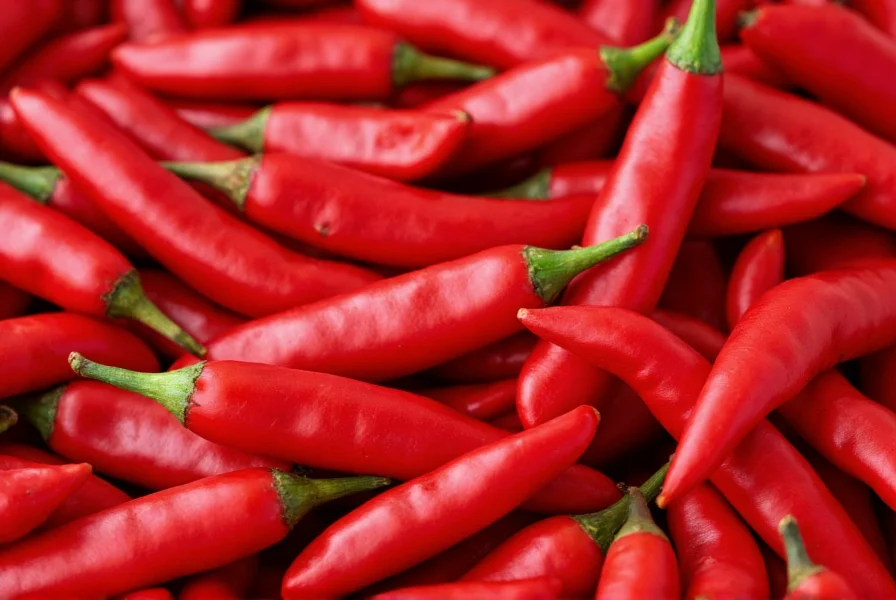Red chilli peppers represent the fully ripened stage of many Capsicum varieties, transforming from green to brilliant red as they mature. This color change signifies increased capsaicin concentration—the compound responsible for their signature heat—along with enhanced sweetness and complex flavor development. Unlike bell peppers which lack capsaicin, true red chilli peppers deliver varying degrees of pungency that culinary enthusiasts and home cooks leverage to elevate dishes worldwide.
Understanding Red Chilli Pepper Varieties
Red chilli peppers encompass numerous cultivars differing significantly in heat level, flavor profile, and culinary application. The scoville heat units (SHU) measurement system helps quantify their pungency:
| Pepper Variety | Scoville Heat Units | Flavor Characteristics |
|---|---|---|
| Cayenne | 30,000-50,000 SHU | Sharp, slightly smoky, earthy |
| Red Jalapeño | 2,500-8,000 SHU | Grassy, bright, moderately hot |
| Serrano | 10,000-23,000 SHU | Crisp, tangy, intense heat |
| Habanero | 100,000-350,000 SHU | Fruity, floral, extremely hot |
| Thai Bird's Eye | 50,000-100,000 SHU | Sharp, citrusy, searing heat |
When selecting different types of red chilli peppers for cooking, consider both heat tolerance and flavor compatibility. Riper red peppers generally offer sweeter, more complex flavors compared to their green counterparts while delivering intensified heat. This maturation process increases capsaicin concentration but also develops sugars that balance the pungency.

Nutritional Profile and Health Benefits
The nutritional value of red chilli peppers makes them valuable beyond their flavor contribution. A single red chilli pepper (45g) typically contains:
- 189% of daily vitamin C requirement
- 42% of daily vitamin A needs
- Significant vitamin B6, potassium, and copper
- Powerful antioxidants including carotenoids and flavonoids
Research supports several health benefits of red chilli peppers. Capsaicin, the active compound responsible for heat, has demonstrated anti-inflammatory properties and may support metabolic health. Regular consumption correlates with improved circulation and cardiovascular function in population studies. The high vitamin C content boosts immune function while carotenoids contribute to eye health.
Culinary Applications Across Global Cuisines
Chefs worldwide leverage how to use red chilli peppers in cooking to create distinctive flavor profiles. In Indian cuisine, dried red chillies form the base of many curry blends, while fresh varieties appear in chutneys and pickles. Mexican cooking features roasted red jalapeños in salsas and adobos, and Thai cuisine relies on bird's eye chillies for authentic heat in curries and stir-fries.
When incorporating red chilli peppers into dishes, consider these professional techniques:
- Remove seeds and white membranes for milder heat
- Toast dried peppers before grinding to enhance flavor complexity
- Balance intense heat with dairy, sugar, or acid components
- Use red chilli oil for controlled heat distribution in dishes
Safety Considerations and Handling Tips
Proper handling ensures safe enjoyment of red chilli pepper varieties. Always wear gloves when preparing extremely hot varieties like habaneros or ghost peppers, and avoid touching your face. If skin contact occurs, use oil or milk to remove capsaicin rather than water, which spreads the compound.
Consumption precautions include:
- Start with small amounts to assess tolerance
- Avoid consumption on an empty stomach
- Have dairy products available to neutralize excessive heat
- Consult a physician before regular consumption if you have gastrointestinal conditions

Storage and Preservation Methods
To maximize shelf life, store fresh red chilli peppers in the refrigerator's crisper drawer for up to three weeks. For longer preservation, consider these effective methods:
- Drying: Air-dry or use a food dehydrator for concentrated flavor
- Freezing: Blanch then freeze whole peppers for year-round use
- Pickling: Create flavorful preserved peppers in vinegar solutions
- Oil infusion: Make custom chili oils for cooking applications
Dried red chilli peppers maintain potency for 6-12 months when stored in airtight containers away from light and moisture. Properly preserved peppers retain both flavor complexity and nutritional benefits for extended periods.
Conclusion
Red chilli peppers offer a remarkable combination of flavor, heat, and nutritional value that has secured their place in kitchens worldwide. Understanding the differences between red chilli pepper vs red pepper varieties allows cooks to select the perfect pepper for any dish. Whether you're exploring mild paprika-infused dishes or adventurous ghost pepper challenges, these vibrant fruits provide versatile culinary possibilities backed by impressive health benefits when consumed responsibly.
Frequently Asked Questions
What's the difference between red chilli peppers and regular red peppers?
True red chilli peppers contain capsaicin that creates heat, while regular red bell peppers belong to the same Capsicum family but lack capsaicin entirely. Red chilli peppers range from mildly hot to extremely spicy (measured in Scoville units), whereas red bell peppers offer sweet, fruity flavors with zero heat. Both turn red when fully ripened, but only chilli peppers deliver the characteristic burning sensation.
How can I reduce the heat of red chilli peppers in cooking?
To reduce heat from red chilli peppers, remove the seeds and white membranes (placenta) where most capsaicin concentrates. Cooking peppers longer breaks down capsaicin, while adding dairy products (milk, yogurt, cheese), sugar, or acidic components (lemon juice, vinegar) counteracts the burning sensation. For extremely hot varieties, consider using less pepper initially and adjusting heat levels gradually.
Are red chilli peppers healthy for daily consumption?
Yes, moderate daily consumption of red chilli peppers offers health benefits including improved metabolism, reduced inflammation, and enhanced circulation. The capsaicin content may support weight management and cardiovascular health. However, individuals with gastrointestinal conditions like ulcers or IBS should consult their physician before regular consumption, as excessive intake may cause discomfort. Balance is key—most people benefit from incorporating red chilli peppers as part of a varied diet.
Why do some red chilli peppers taste sweeter than others?
The sweetness in red chilli peppers develops as they ripen from green to red. During maturation, starches convert to sugars while capsaicin levels increase. Varieties like red bell peppers (technically not hot peppers) and certain cultivars such as sweet Hungarian wax peppers prioritize sugar development over heat. Growing conditions, soil composition, and harvest timing also influence the final sugar-to-heat ratio in different red chilli pepper varieties.











 浙公网安备
33010002000092号
浙公网安备
33010002000092号 浙B2-20120091-4
浙B2-20120091-4